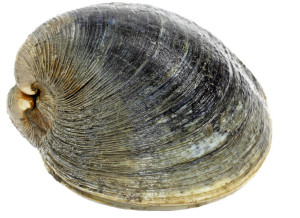What’s so special
about this? Believe
it or not, this is the
world’s oldest animal
Ocean quahogs (Artica islandica) are found in the North Atlantic. The oldest recorded specimen was 507 years old. Their rings can also tell us a lot about climate change. The proposed South Rigg Marine Conservation Zone (MCZ) in the Irish Sea may offer them some protection in years to come.
The Marine Management Organisation (MMO) has recently introduced MCZ Assessments. Here we look a bit deeper to see what’s involved.
MCZ Assessments must now be completed for marine licence applications for development proposals in and around MCZs. They are required in accordance with the MMO’s own regulatory obligations under Section 126 of the Marine & Coastal Access Act 2009. Currently 27 MCZs are designated around the English coast, both inshore and offshore; a decision is expected early in 2016 with regard to the possible designation of a further 23 MCZs. But will the MCZ Assessment process bolster the existing environmental assessment process and help to conserve and enhance our marine resource? Or will it lead to confusion, costly programme delays and the risk of assessment fatigue?
The MCZ Assessment process comprises three stages: Screening, Stage 1 Assessment and Stage 2 Assessment; similar to the process already undertaken for Marine Special Areas of Conservation (SACs) as part of Habitats Regulations Assessment (HRA) and Environmental Impact Assessment (EIA) in the UK. Many species and habitats designated for protection in MCZs are already assessed because they are on the:
- Oslo and Paris Convention (OSPAR) List (of Threatened and/or Declining Species and Habitats).
- UK List of Priority Species and Habitats (now Sections 41 and 42 of the Natural Environment and Rural Communities (NERC) Act 2006).
So what do MCZ Assessments offer over and above the existing environmental assessment process?
Principally, MCZs provide new protection for broad-scale habitats and some species, and further protection for all species and habitats (via conservation objectives for each species and habitat in each MCZ). The screening process ascertains whether the development proposal is likely to affect these MCZ designated species and habitats or not, and the Stage 1 Assessment looks in more detail at how the conservation objectives of each designated species and habitat could be affected and how the impact may be mitigated. A Stage 2 Assessment is required for critical infrastructure proposals that are unable to fully mitigate the impact on the MCZ designated species and habitats.
Critically, the evidence provided in the Stage 2 Assessment will be of key importance in securing the marine licence for many large coastal, inshore and offshore developments. This needs to:
- Demonstrate that “the benefit to the public of proceeding with the act clearly outweigh the risk of damage to the environment that will be created by proceeding with it; and, if so, then;
- Satisfy the MMO that the applicant will undertake or make arrangements for the undertaking of measures of equivalent environmental benefit (MEEB) to the damage which the act will have or is likely to have in or on the MCZ”.
The MMO is currently preparing technical guidance regarding all stages of the MCZ assessment process, which will also refer to the evidence required to assess the public benefit of a scheme.
Black & Veatch’s approach is to seamlessly integrate MCZ Assessments (screening, Stage 1 and Stage 2) into EIA where ever possible, to ensure no unnecessary duplication of work and cost to the licence applicant. For Stage 2, we can describe, quantify and monetise the net public benefit (over and above any dis-benefits) of a development proposal, compared to alternative options. Our approach is to set out the compelling economic evidence that demonstrates the public benefit locally, regionally and nationally; by streamlining the evidence from economic cost-benefit analysis, economic impact assessment, EIA and ecosystem services assessments into our MCZ Assessments.
Whilst guidance is being developed for Stage 2 Assessments, Black & Veatch draws on its expertise in analysing economic and environmental evidence using our integrated team, to determine whether a scheme has an ‘overriding public benefit’. We have done this for various marine sites through a number of HRA ‘Statements of Case’ to demonstrate “Imperative Reasons of Overriding Public Interest” for critical coastal infrastructure.
In conclusion, whilst MCZ Assessments may in some respects appear to be a duplication of similar assessments in EIA, HRA and Water Framework Directive (WFD); critically they fill a gap in protection for our marine resource. Sensibly, the approach set out by the MMO follows a tried and tested method which, if streamlined with existing environmental assessment processes, can be met in a cost-efficient and proportionate manner without the risk of undue assessment fatigue.
Black & Veatch is best placed to complete MCZ Assessments based on our knowledge and expertise of MCZs, EIA, HRA and WFD for critical coastal and marine infrastructure. We have detailed knowledge of MCZs, how they were identified, the designation process and key assumptions and evidence used in the cost-benefit analysis including species and habitats sensitivity data. Our Senior Economist was project economist for the Irish Sea MCZ regional project and continues to provide economic expertise to Defra regarding the designation of MCZs. We are also best placed to liaise with our contacts within MMO, Natural England, JNCC, Cefas and Defra to access recent research when relevant to do so.
Click on the links for a summary of Black & Veatch’s project experience in Habitats Regulations Assessment and Marine Economics.
For more information, please contact Francesca Moore, Senior Environmental Economist on mooref@bv.com or 01244 304119
